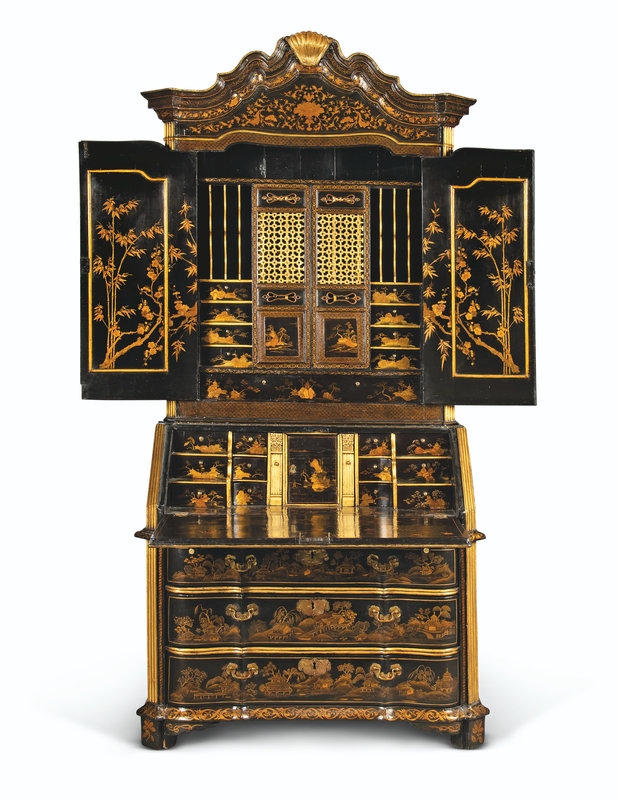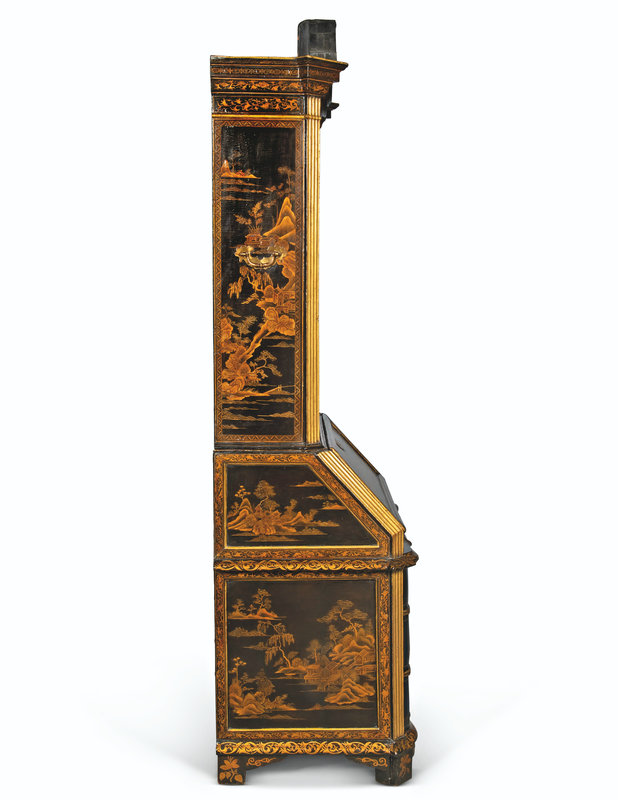Note: As early as the 16th Century, during the Momoyama period, lacquered goods were exported from Japan and shipped to the West by the Portuguese. Further goods came from China from the early 17th Century, with the East India Company being the channel through which much of the merchandise found its way to this country. The exotic quality of the lacquer, made from the sap of the rhus vernicifera, greatly appealed to the Western market and inspired the Western art of 'japanning' in imitation of laquer.
Towards the end of the 17th Century, patterns of cabinet work were being sent out for the Chinese to copy. A document from circa 1700 records that several artificers were sent out by the East India Company with 'great quantities of English patterns to teach the Indians how to manufacture goods to make them vendible in England and the rest of the European markets. After which began the great trade in manufactured goods from the Indies' (quoted in M. Jourdain and R. Soame Jenyns, Chinese Export Art in the Eighteenth Century, London, 1967, p. 19). The present bureau-cabinet, with its pedimented cornice in the 'Roman' manner, relates to contemporary George II bureau-cabinets, however in typical Chinese manner, the curved elements such as the cornice and waist-moulding have been exaggerated and the drawer fronts themselves shaped to pleasing effect. The elaborate lock-plates recall those on Chinese-Export cabinets which were imported in large numbers from the 17th Century and 'married' with European bases.
In 1738 a pair of related bureau-cabinets, again in the George II manner, was shipped back from Canton to Copenhagen and sold to Christian VI of Denmark, both of which are now in Fredensborg Castle (T. Clemmensen, 'Some Furniture made in China in the English style, exported from Canton to Denmark 1735, 1737 and 1738', Furniture History, 1985, p. 176, figs. 5 and 7). Another related bureau-cabinet where the Chinese exaggerated curves on the cornice and drawer-fronts are clearly exemplified, is illustrated in M. Jourdain and R. Soame Jenyns, op. cit., p. 85, fig. 24, while another bureau-cabinet sharing some of the foliate motifs and foliate-decorated arched pediment was sold anonymously, Christie's New York, 19 October 2000, lot 131 ($127,000 inc. premium).
Towards the end of the 17th Century, patterns of cabinet work were being sent out for the Chinese to copy. A document from circa 1700 records that several artificers were sent out by the East India Company with 'great quantities of English patterns to teach the Indians how to manufacture goods to make them vendible in England and the rest of the European markets. After which began the great trade in manufactured goods from the Indies' (quoted in M. Jourdain and R. Soame Jenyns, Chinese Export Art in the Eighteenth Century, London, 1967, p. 19). The present bureau-cabinet, with its pedimented cornice in the 'Roman' manner, relates to contemporary George II bureau-cabinets, however in typical Chinese manner, the curved elements such as the cornice and waist-moulding have been exaggerated and the drawer fronts themselves shaped to pleasing effect. The elaborate lock-plates recall those on Chinese-Export cabinets which were imported in large numbers from the 17th Century and 'married' with European bases.
In 1738 a pair of related bureau-cabinets, again in the George II manner, was shipped back from Canton to Copenhagen and sold to Christian VI of Denmark, both of which are now in Fredensborg Castle (T. Clemmensen, 'Some Furniture made in China in the English style, exported from Canton to Denmark 1735, 1737 and 1738', Furniture History, 1985, p. 176, figs. 5 and 7). Another related bureau-cabinet where the Chinese exaggerated curves on the cornice and drawer-fronts are clearly exemplified, is illustrated in M. Jourdain and R. Soame Jenyns, op. cit., p. 85, fig. 24, while another bureau-cabinet sharing some of the foliate motifs and foliate-decorated arched pediment was sold anonymously, Christie's New York, 19 October 2000, lot 131 ($127,000 inc. premium).

/https%3A%2F%2Fprofilepics.canalblog.com%2Fprofilepics%2F1%2F0%2F100183.jpg)
/https%3A%2F%2Fstorage.canalblog.com%2F03%2F02%2F119589%2F96711876_o.jpg)
/https%3A%2F%2Fstorage.canalblog.com%2F11%2F31%2F119589%2F94773502_o.jpg)
/https%3A%2F%2Fstorage.canalblog.com%2F20%2F83%2F119589%2F94772815_o.jpg)
/https%3A%2F%2Fstorage.canalblog.com%2F26%2F72%2F119589%2F75604929_o.jpg)
/https%3A%2F%2Fstorage.canalblog.com%2F59%2F60%2F119589%2F26458628_o.jpg)






/http%3A%2F%2Fstorage.canalblog.com%2F64%2F03%2F119589%2F128488681_o.jpg)
/http%3A%2F%2Fstorage.canalblog.com%2F62%2F18%2F119589%2F128488091_o.jpg)
/http%3A%2F%2Fstorage.canalblog.com%2F22%2F38%2F119589%2F120404804_o.jpg)
/http%3A%2F%2Fstorage.canalblog.com%2F03%2F20%2F119589%2F112763502_o.jpg)